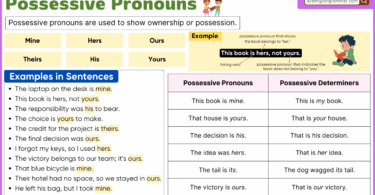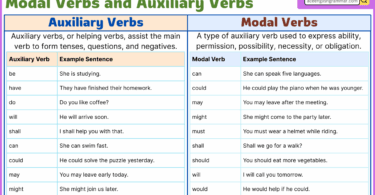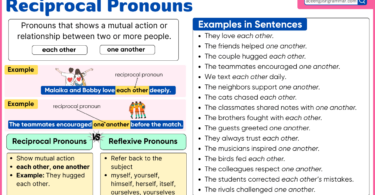In English grammar, one of the most common and often confusing mistakes is the dangling modifier. A modifier is a word or phrase that adds information to a sentence, providing clarity or additional details. However, when that modifier doesn’t clearly relate to the word it’s supposed to modify, it’s called a dangling modifier. This can cause confusion and sometimes create unintended meanings. Let’s break down this concept step by step to ensure that learners of all levels can grasp it and avoid making this error in their writing.
Table of Contents
What Is a Dangling Modifier?
A dangling modifier is a phrase or word that modifies a word not clearly stated in the sentence. When this happens, the modifier is “dangling,” or not properly connected to the word it’s supposed to modify. Often, the sentence will appear to be saying something the writer didn’t intend, leading to confusion or a lack of clarity.
Here is an example of a sentence with a dangling modifier:
- Running down the street, the backpack slipped off. ❌
In this sentence, “Running down the street” seems to modify “the backpack,” which is incorrect. Backpacks can’t run! The intended subject, the person running, is missing. The sentence should be rewritten for clarity:
- Running down the street, I felt the backpack slip off. ✅
How to Identify a Dangling Modifier
To identify a dangling modifier, follow these steps:
- Find the modifier: Look for phrases or words that describe an action or add information.
- Identify the subject: Ensure the subject being described is present in the sentence.
- Check the connection: Make sure the modifier clearly relates to the subject of the sentence.
If the modifier doesn’t logically modify the subject, you likely have a dangling modifier.
Common Types of Dangling Modifiers
- Participial phrases: These are phrases starting with present or past participles (verbs ending in -ing or -ed). For example:
- ❌ Hiking the mountain trail, the view was stunning.
(It seems like the view is doing the hiking.) - ✅ Hiking the mountain trail, we were awed by the stunning view.
- ❌ Hiking the mountain trail, the view was stunning.
- Infinitive phrases: These are phrases starting with the infinitive form of a verb (to + verb). For example:
- ❌ To win the competition, practice must be consistent.
(This suggests that “practice” wants to win the competition.) - ✅ To win the competition, you must practice consistently.
- ❌ To win the competition, practice must be consistent.
- Prepositional phrases: These start with a preposition and often lack a clear subject. For example:
- ❌ After finishing dinner, the TV was turned on.
(The sentence seems to suggest that the TV finished dinner!) - ✅ After finishing dinner, we turned on the TV.
- ❌ After finishing dinner, the TV was turned on.
How to Correct Dangling Modifiers
Correcting a dangling modifier can be done by either:
Including the intended subject: Make sure the subject being modified is present and clearly connected to the modifier.
- Dangling: While reading the book, the room seemed quieter.
- Corrected: While I was reading the book, the room seemed quieter.
Rewriting the sentence: If the modifier can’t be easily attached to the subject, rewrite the sentence for clarity.
- Dangling: Having completed the project, a break was well-deserved.
- Corrected: Having completed the project, we felt a break was well-deserved.
Misplaced vs. Dangling Modifiers
While dangling modifiers are a type of error, they are closely related to misplaced modifiers. A misplaced modifier is in the wrong position in the sentence, leading to confusion. However, unlike a dangling modifier, a misplaced modifier still has its subject present, but it’s located incorrectly.
For example:
- Misplaced: She nearly ate all the cake.
(This suggests that she almost ate all the cake but didn’t.) - Correct: She ate nearly all the cake.
(Now the meaning is clear: she ate most of the cake.)
Why Dangling Modifiers Matter
Dangling modifiers can cause major confusion for readers. They make your writing sound awkward, unclear, or even humorous—although unintentionally. Properly constructing sentences ensures that the reader understands your message without difficulty. For students, writers, and professionals alike, avoiding dangling modifiers is crucial for effective communication.
Tips for Avoiding Dangling Modifiers
Ensure the subject follows the modifier: Right after a modifier, make sure the person or thing being described is clearly identified.
- ❌ Without knowing the rules, the game was confusing.
- ✅ Without knowing the rules, we found the game confusing.
Avoid vague subjects: Use specific nouns rather than vague pronouns to make it clear who is performing the action.
- ❌ After studying all night, it was obvious the exam would be hard.
- ✅ After studying all night, we realized the exam would be hard.
Read your sentences aloud: Sometimes, hearing a sentence helps to identify awkward phrasing or unclear connections between the modifier and the subject.
Ask questions about the sentence: Who is performing the action? What is being modified? Is the subject clear?
Conclusion
Understanding and avoiding dangling modifiers is key to improving your writing clarity. By ensuring that modifiers are properly attached to their subjects, you’ll not only avoid awkward and confusing sentences but also ensure that your writing is professional and polished. Whether you’re writing an academic paper, blog post, or business email, mastering this grammar rule will help you communicate more effectively.
Read More



